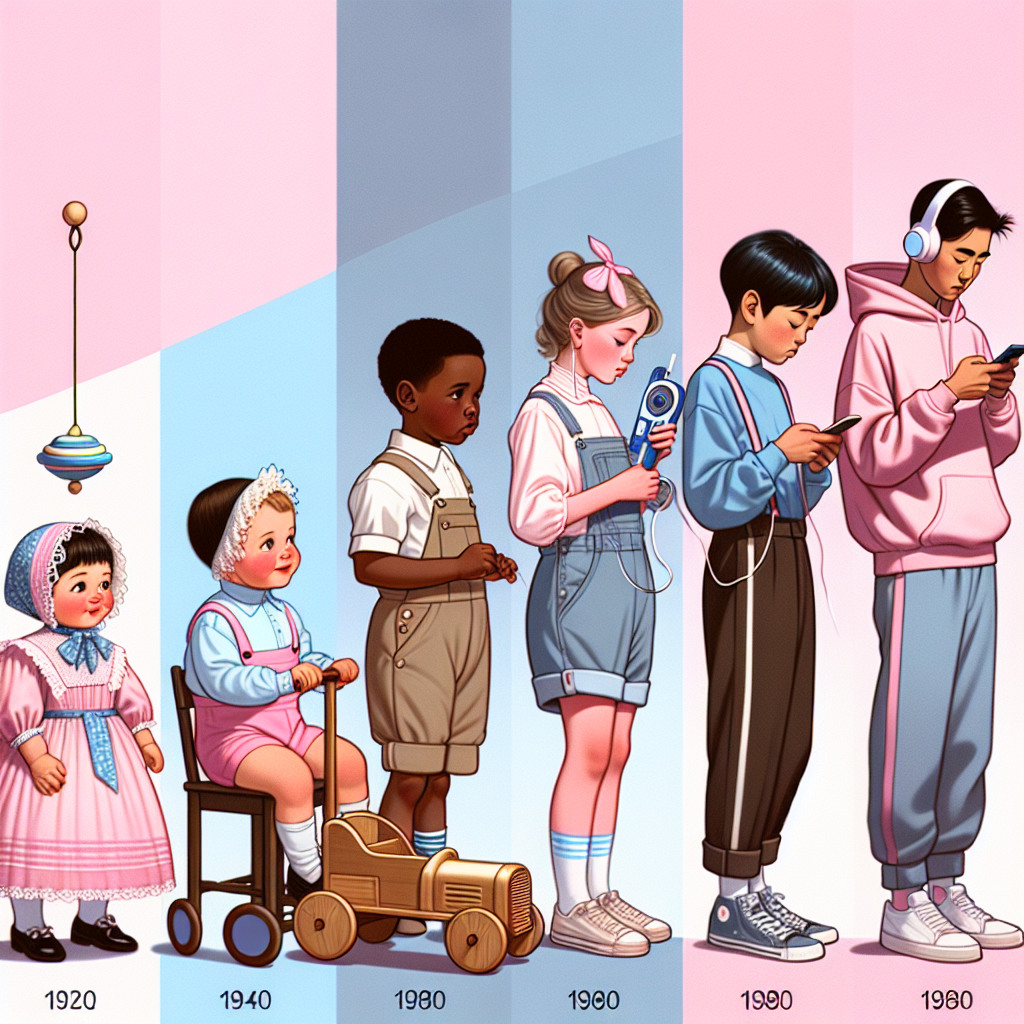
Introduction
Imagine a little girl dressed in head-to-toe pink, surrounded by dolls and sparkly accessories, while a boy in a blue T-shirt and jeans plays with trucks and action figures. This scenario epitomizes the traditional gender norms associated with children’s fashion, but is it really as simple as it seems? The journey from pink to blue, and vice versa, unveils a complicated tapestry of societal expectations, cultural shifts, and individual expression.
Understanding the evolution of gender norms in children’s fashion is not just about color palettes; it’s about the underlying ideologies that shape our perceptions of masculinity and femininity from a young age. This article, “From Pink to Blue: The Evolution of Gender Norms in Children’s Fashion,” unpacks these themes, examining how historical contexts, influential figures, and contemporary trends have transformed the way we dress our children. So, let us dive into this colorful world where clothing tells a story far deeper than mere fabric and thread.
The Historical Background: How Colors Became Gendered
The association of colors with gender isn’t as ancient as many might believe. In fact, in the early 20th century, things were quite different. According to a study conducted by historians, baby boys were often dressed in pink, viewed as a softer version of red, while girls were swathed in blue, considered dainty and delicate.
Case Study: Early 20th Century Trends
In the 1920s, a conservative approach to children’s fashion began to coalesce into what we recognize today. Retailers began promoting pink for girls and blue for boys, with marketing campaigns pushing these narratives. The transition solidified during the 1940s, notably when the widespread popularity of World War II led to a more definitive gendered marketing approach.
Analysis: This early shift in color association illustrates that societal needs – such as war and economy – can create norms that influence children’s fashion for decades to come.
The 1970s: A Glimmer of Fluidity
The 1970s represented a radical departure from traditional gender norms across multiple domains, including fashion. With the women’s liberation movement gaining momentum, many began to question and resist established notions of femininity and masculinity, leading to unisex clothing becoming a trend.
Case Study: Unisex Fashion Brands
Pioneering brands like "GAP" started featuring unisex clothing lines, providing a bridge between traditional gender norms and a more liberated approach. The availability of gender-neutral styles allowed parents to select clothes based on preference rather than societal dictates.
Analysis: This era’s impact is still evident in today’s market, where many brands recognize the need for offerings that appeal to a wider audience beyond traditional gender specifications.
The Influence of Pop Culture and Media
Fast forward to the 21st century. The emergence of social media and representation in pop culture has played a significant role in reshaping children’s fashion. Characters in movies, television shows, and even influential public figures contribute enormously to the dialogue surrounding gender norms.
Case Study: Celebrities and Fashion
Consider the influence of figures like Angelina Jolie, whose children have often been seen wearing clothing that defies traditional gender expectations. Similarly, the children’s television show "Steven Universe" explores themes of gender identity and presents characters who blend traditional gender roles.
Analysis: The power of representation can’t be underestimated. As children see diverse fashion ideals reflected in media, they are more likely to push back against restrictive norms in their own wardrobes.
The Role of Fashion Brands
In recent years, several fashion brands have committed to breaking down gender-based clothing divisions. Labels like "Taf TF" and "TomboyX" have embraced inclusivity, creating fashion lines that cater to all children, regardless of gender.
Chart: Brand Adoption of Gender-Neutral Clothing
| Brand | Year Established | Gender-Neutral Lines Offered |
|---|---|---|
| Taf TF | 2016 | Tops, bottoms, and outerwear |
| TomboyX | 2014 | Underwear, activewear, and loungewear |
| Mini Rodini | 2006 | Diverse patterns for all genders |
Analysis: This table underscores a larger industry shift fostering inclusivity and diversity in children’s fashion. Brands are adopting new philosophies, aiming to empower children to express themselves freely through clothing.
The Push for Gender-inclusivity
Parents today are increasingly concerned with the implications of gendered clothing for their children. Many are keen on fostering an environment where kids can learn self-expression without having to conform to the outdated binaries of "pink for girls" and "blue for boys."
Case Study: Parent Activism
Groups like "Let Clothes Be Clothes" have spearheaded campaigns advocating for the removal of gender labels in children’s clothing sections. Their mission is to encourage retailers to present clothes based on style rather than gender conformity.
Analysis: Activism in this space showcases the power of collective voice and reveals an urgency for change that resonates with contemporary parenting ideologies.
Data-Driven Insights
Recent surveys indicate a significant shift in parental attitudes. According to a survey by the U.S. Consumer Product Safety Commission, around 70% of parents now claim they prefer gender-neutral clothing for their children.
Table: Parent Preferences on Children’s Fashion
| Year | Prefer Gender-Neutral | Prefer Gendered Clothing |
|---|---|---|
| 2015 | 45% | 55% |
| 2020 | 70% | 30% |
Analysis: The shift in preferences is dramatic, illustrating a societal move toward inclusivity that continues to influence children’s fashion trends.
The Future of Children’s Fashion
As we look ahead, the potential for further evolution in children’s fashion is bright. Increased awareness and acceptance of diverse gender identities will likely propel the market toward more flexible options—ones that emphasize self-expression rather than conformity.
Emerging Trends
- Sustainable Fashion: Eco-friendly brands that also promote inclusivity are expected to take center stage.
- Cultural Representation: Fashion that represents a diverse array of cultures will likely gain popularity, catering to children of various backgrounds.
Analysis: Future trends indicate a move toward more holistic approaches to children’s fashion, embracing individuality, sustainability, and cultural representation.
Conclusion
The journey from pink to blue is not just about colors; it encapsulates a larger discourse of what childhood means in the 21st century. As society grapples with the complexities of gender identity and expression, children’s fashion is evolving to reflect these changes. We stand at a crossroads of tradition and progression, where the potential for individual expression in children’s clothing is boundless.
As you consider the fashion choices for the children in your life, remember that what they wear can foster independence, creativity, and self-expression. Let’s support a culture where our children can choose their colors freely—whether pink, blue, or a magnificent rainbow.
FAQs Section
1. Why are pink and blue traditionally linked to girls and boys?
Historically, these color associations became prominent in the 1940s due to marketing strategies and societal norms that enforced gender binaries.
2. How can I encourage gender-neutral clothing choices for my child?
Introduce your child to style options that include diverse colors and designs. Take them shopping and let them select outfits that resonate with them personally, irrespective of traditional gender roles.
3. Are there benefits to dressing children in gender-neutral clothing?
Yes! Gender-neutral clothing can foster creativity, promote inclusivity, and enable children to explore their identities freely.
4. What should I look for when shopping for inclusive children’s fashion?
Search for brands that emphasize unisex options, utilize diverse models in their campaigns, and prioritize sustainable materials. Read reviews and consider community feedback on the inclusivity of the brand.
5. How is social media influencing children’s fashion choices?
Platforms like Instagram and TikTok foster trends that blur gender lines, encouraging children to explore and express their identities boldly. They also provide platforms for visibility of diverse styles and narratives.
With historic relevance, case studies, projected trends, and an emphasis on inclusivity, “From Pink to Blue: The Evolution of Gender Norms in Children’s Fashion” offers valuable insights into this evolving landscape. As we continue to navigate the complexities of gender identity, the way we dress our children is just one canvas where society reflects its changes.

















